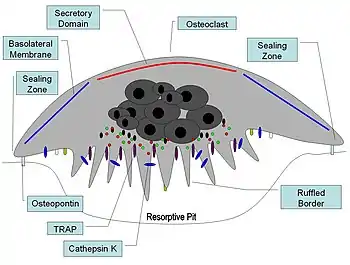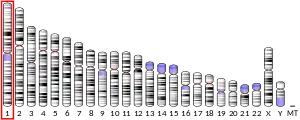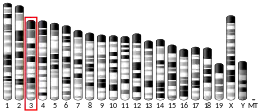组织蛋白酶K
组织蛋白酶K(英语:Cathepsin K),是一种在人体中由CTSK基因编码的酶。[7][8]
功能
该基因编码的蛋白质是半胱氨酸组织蛋白酶,一种参与骨重塑和再吸收的溶酶体半胱氨酸蛋白酶。这种蛋白质是肽酶C1蛋白质家族的成员,主要在破骨细胞中表达。
组织蛋白酶K是一种蛋白酶,其特征在于其对激肽的高度特异性,与骨吸收有关。该酶分解代谢弹性蛋白、胶原蛋白和明胶的能力使其能够分解骨骼和软骨。这种分解代谢活动也是肺弹性丧失和肺气肿反冲的部分原因。组织蛋白酶K抑制剂在骨质疏松症的治疗中显示出巨大的潜力。在被称为受控组织蛋白酶同类相食的过程中,组织蛋白酶K被组织蛋白酶S降解。
临床意义
组织蛋白酶K在很大一部分人类乳癌中表达,它可能有助于肿瘤侵袭性。[9]该基因的突变是致密性成骨不全症的原因,这是一种以骨质硬化和身材矮小为特征的常染色体隐性遗传病。[10]组织蛋白酶K也被发现在胶质母细胞瘤中过度表达。[11]
组织蛋白酶K的表达是某些癌症的特征,而其他癌症则没有。[12]组织蛋白酶K抗体已上市销售,用于研究该酶在各种细胞中的表达。[13][14][15]
默克公司在骨质疏松症的III期临床试验中使用了一种组织蛋白酶K抑制剂,奥达那替尼。2016年9月,默克公司在自行评估不良事件后宣布停止开发奥达那替尼,独立评估显示中风风险增加。[16][17]其他组织蛋白酶K抑制剂处于不同的发展阶段。[18][19]截至2017年10月,Medivir公司有一种组织蛋白酶K抑制剂MIV-711(L-006235[20][21][22]),在IIa期临床试验中,作为一种改善骨关节炎的药物。
参考文献
- .
- .
- GRCh38: Ensembl release 89: ENSG00000143387 - Ensembl, May 2017
- GRCm38: Ensembl release 89: ENSMUSG00000028111 - Ensembl, May 2017
- . National Center for Biotechnology Information, U.S. National Library of Medicine.
- . National Center for Biotechnology Information, U.S. National Library of Medicine.
- .
- Inaoka T, Bilbe G, Ishibashi O, Tezuka K, Kumegawa M, Kokubo T. . Biochemical and Biophysical Research Communications. January 1995, 206 (1): 89–96. PMID 7818555. doi:10.1006/bbrc.1995.1013.
- Duong LT, Wesolowski GA, Leung P, Oballa R, Pickarski M. . Molecular Cancer Therapeutics. 23 September 2014, 13 (12): 2898–909 [2 October 2016]. PMID 25249554. doi:10.1158/1535-7163.MCT-14-0253
 . (原始内容存档于2019-08-24).
. (原始内容存档于2019-08-24). - . NCBI Gene. National Center for Biotechnology Information, U.S. National Library of Medicine. 4 September 2016 [2 October 2016]. (原始内容存档于2022-10-31).
- Verbovšek U, Motaln H, Rotter A, Atai NA, Gruden K, Van Noorden CJ, Lah TT. . PLOS ONE. 30 October 2014, 9 (10): e111819. Bibcode:2014PLoSO...9k1819V. PMC 4214761
 . PMID 25356585. doi:10.1371/journal.pone.0111819
. PMID 25356585. doi:10.1371/journal.pone.0111819  .
. - Argani, Pedram; et al. . American Journal of Clinical Pathology. 1 February 2013, 139 (2): 151–159. PMC 3957187
 . PMID 23355199. doi:10.1309/AJCPDTRTO2Z4UEXD.
. PMID 23355199. doi:10.1309/AJCPDTRTO2Z4UEXD. - . Novus Biologicals online catalog. Novus Biologicals, LLC. 2016 [2 October 2016]. (原始内容存档于2022-10-31).
- . Abcam plc online catalog. Abcam plc. 2016 [2 October 2016]. (原始内容存档于2022-10-31).
- . Antibodies.com online catalog. Antibodies.com Ltd. 2018 [16 January 2018]. (原始内容存档于2018-01-17).
- Brömme, Dieter; Lecaille, Fabien. . Expert Opinion on Investigational Drugs. 24 April 2009, 18 (5): 585–600. PMC 3110777
 . PMID 19388876. doi:10.1517/13543780902832661.
. PMID 19388876. doi:10.1517/13543780902832661. - . Merck Sharp & Dohme Corp. 2 September 2016 [1 October 2016]. (原始内容存档于2016-11-09).
- Asagiri M, Hirai T, Kunigami T, Kamano S, Gober HJ, Okamoto K, Nishikawa K, Latz E, Golenbock DT, Aoki K, Ohya K, Imai Y, Morishita Y, Miyazono K, Kato S, Saftig P, Takayanagi H,. (2008). Cathepsin K-dependent toll-like receptor 9 signaling revealed in experimental arthritis. Science, 319(5863), 624-627.
- Hussein, H., Ishihara, A., Menendez, M., & Bertone, A. (2014). Pharmacokinetics and bone resorption evaluation of a novel Cathepsin K inhibitor (VEL‐0230) in healthy adult horses. Journal of veterinary pharmacology and therapeutics.
- . www.medivir.se. [2017-10-06]. (原始内容存档于6 October 2017) (英语).
- Burston JJ, Xu L, Mapp PI, Grabowska U, Tunblad K, Lindström E, Chapman V. (PDF). www.medivir.se. April 2016 [6 October 2017]. (原始内容 (PDF)存档于6 October 2017).
- (PDF). mb.cision.com. 14 September 2017 [2022-10-31]. (原始内容存档 (PDF)于2022-08-21).
阅读
- Motyckova G, Fisher DE. . Current Molecular Medicine. 2003, 2 (5): 407–21. PMID 12125807. doi:10.2174/1566524023362401.
- Troen BR. . Annals of the New York Academy of Sciences. 2006, 1068 (1): 165–72. Bibcode:2006NYASA1068..165T. PMID 16831915. S2CID 8117602. doi:10.1196/annals.1346.018.
- Del Nery E, Chagas JR, Juliano MA, et al. . The Biochemical Journal. 1996, 312 (1): 233–8. PMC 1136249
 . PMID 7492318. doi:10.1042/bj3120233.
. PMID 7492318. doi:10.1042/bj3120233. - Brömme D, Okamoto K. . Biological Chemistry Hoppe-Seyler. 1995, 376 (6): 379–84. PMID 7576232. doi:10.1515/bchm3.1995.376.6.379.
- Gelb BD, Edelson JG, Desnick RJ. . Nature Genetics. 1995, 10 (2): 235–7. PMID 7663521. S2CID 24297764. doi:10.1038/ng0695-235.
- Polymeropoulos MH, Ortiz De Luna RI, Ide SE, et al. . Nature Genetics. 1995, 10 (2): 238–9 [2022-10-31]. PMID 7663522. S2CID 11723845. doi:10.1038/ng0695-238. (原始内容存档于2022-10-31).
- Shi GP, Chapman HA, Bhairi SM, et al. (PDF). FEBS Letters. 1995, 357 (2): 129–34. PMID 7805878. S2CID 28099876. doi:10.1016/0014-5793(94)01349-6
 .
. - Inaoka T, Bilbe G, Ishibashi O, et al. . Biochemical and Biophysical Research Communications. 1995, 206 (1): 89–96. PMID 7818555. doi:10.1006/bbrc.1995.1013.
- Velasco G, Ferrando AA, Puente XS, et al. . The Journal of Biological Chemistry. 1994, 269 (43): 27136–42. PMID 7929457. doi:10.1016/S0021-9258(18)47135-9
 .
. - Li YP, Alexander M, Wucherpfennig AL, et al. . Journal of Bone and Mineral Research. 1996, 10 (8): 1197–202. PMID 8585423. S2CID 41832979. doi:10.1002/jbmr.5650100809.
- Bossard MJ, Tomaszek TA, Thompson SK, et al. . Journal of Biological Chemistry. 1996, 271 (21): 12517–24. PMID 8647860. doi:10.1074/jbc.271.21.12517
 .
. - Gelb BD, Shi GP, Chapman HA, Desnick RJ. . Science. 1996, 273 (5279): 1236–8. Bibcode:1996Sci...273.1236G. PMID 8703060. S2CID 7188076. doi:10.1126/science.273.5279.1236.
- Johnson MR, Polymeropoulos MH, Vos HL, et al. . Genome Research. 1997, 6 (11): 1050–5. PMID 8938428. doi:10.1101/gr.6.11.1050
 .
. - Littlewood-Evans A, Kokubo T, Ishibashi O, et al. . Bone. 1997, 20 (2): 81–6. PMID 9028530. doi:10.1016/S8756-3282(96)00351-1.
- McGrath ME, Klaus JL, Barnes MG, Brömme D. . Nature Structural Biology. 1997, 4 (2): 105–9. PMID 9033587. S2CID 22175354. doi:10.1038/nsb0297-105.
- Rood JA, Van Horn S, Drake FH, et al. . Genomics. 1997, 41 (2): 169–76. PMID 9143491. doi:10.1006/geno.1997.4614.
- Gelb BD, Shi GP, Heller M, et al. . Genomics. 1997, 41 (2): 258–62. PMID 9143502. doi:10.1006/geno.1997.4631.
- Gomes RA, Juliano L, Chagas JR, Hial V. . Canadian Journal of Physiology and Pharmacology. 1997, 75 (6): 757–61. PMID 9276160. doi:10.1139/cjpp-75-6-757.
- Thompson SK, Halbert SM, Bossard MJ, et al. . Proceedings of the National Academy of Sciences. 1998, 94 (26): 14249–54. PMC 24926
 . PMID 9405598. doi:10.1073/pnas.94.26.14249
. PMID 9405598. doi:10.1073/pnas.94.26.14249  .
. - Gelb BD, Willner JP, Dunn TM, et al. . The American Journal of Human Genetics. 1998, 62 (4): 848–54. PMC 1377035
 . PMID 9529353. doi:10.1086/301795.
. PMID 9529353. doi:10.1086/301795.
图集
 Osteoclast
Osteoclast
外部链接
- The MEROPS online database for peptidases and their inhibitors: C01.036
- 醫學主題詞表(MeSH):Cathepsin+K
This article is issued from Wikipedia. The text is licensed under Creative Commons - Attribution - Sharealike. Additional terms may apply for the media files.





